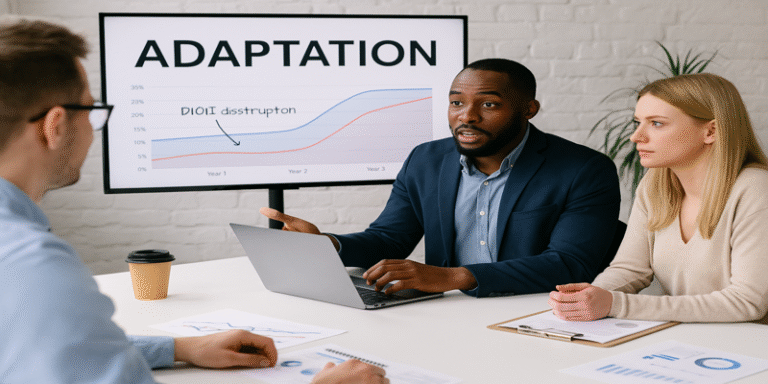In today’s dynamic business environment, the ability of organisations for adaptation is critical for sustaining long-term success and competitiveness. Strategic adaptation refers to the continuous process of adjusting organisational strategies, structures, and processes in response to internal and external changes (Rumelt et al., 2019). Unlike static approaches to strategy, adaptation recognises the uncertainty and turbulence inherent in global markets, technological advancements, and shifting consumer preferences.
This article explores the significance of adaptation in strategic management, the theoretical foundations underpinning adaptive strategies, the role of dynamic capabilities, and practical examples of how organisations achieve sustained competitiveness through adaptation.
The Importance of Strategic Adaptation
Strategic adaptation ensures that organisations remain relevant amidst environmental changes. Factors such as globalisation, technological disruption, evolving regulatory frameworks, and changes in consumer behaviour necessitate continuous realignment of strategies (Teece, 2007). Organisations that fail to adapt risk losing their competitive position, as illustrated by the decline of Blockbuster, which was unable to respond effectively to digital streaming innovations, while Netflix transformed from a DVD rental service into a dominant online streaming platform (McDonald & Eisenhardt, 2020).
Adaptation also enhances resilience by allowing firms to not only respond to crises but also anticipate opportunities. For example, during the COVID-19 pandemic, organisations such as Zoom rapidly scaled their technological infrastructure to meet the surge in demand, demonstrating the importance of adaptive capacity in uncertain times (Seetharaman, 2020).
Theoretical Foundations of Adaptation
The academic basis of strategic adaptation is grounded in theories such as Contingency Theory, the Dynamic Capabilities Framework, and Organisational Learning Theory.
- Contingency Theory suggests that there is no single best way to organise or strategise; instead, the effectiveness of a strategy depends on the fit between the organisation and its environment (Donaldson, 2001).
- The Dynamic Capabilities Framework (Teece, Pisano & Shuen, 1997) emphasises the ability of organisations to sense, seize, and transform resources to match environmental demands. This perspective argues that long-term success is not about possessing resources but about renewing and reconfiguring them.
- Organisational Learning Theory highlights the importance of continuous learning and knowledge integration for adaptation. Organisations that encourage learning are more likely to identify changes early and innovate accordingly (Argyris & Schön, 1996).
Dynamic Capabilities and Adaptation
A central concept in strategic adaptation is the notion of dynamic capabilities. These capabilities go beyond operational effectiveness and focus on the ability of firms to reconfigure competencies in response to changing environments (Teece, 2007).
Examples include:
- Apple’s innovation ecosystem, where capabilities in design, supply chain management, and marketing are continually reconfigured to launch new products.
- Toyota’s lean manufacturing system, which evolved into a model of adaptive efficiency, allowing the company to maintain competitiveness across decades (Liker, 2004).
- Research shows that firms with strong dynamic capabilities are better equipped to navigate digital transformation, global competition, and regulatory change (Benini, Nikou & Calabretta, 2025).
Organisational Culture and Strategic Adaptation
Adaptation is not merely structural or operational; it also involves a transformation in organisational culture. Adaptive organisations foster a culture of innovation, agility, and continuous learning.
For instance, Google’s 20% time policy encouraged employees to pursue innovative projects outside their regular roles, leading to the development of services such as Gmail. Similarly, Spotify’s agile squad model demonstrates how cultural flexibility enables rapid innovation in response to user demands (Denning, 2018).
Conversely, organisations resistant to cultural adaptation often face decline. Kodak, despite pioneering digital photography, clung to its traditional film-based business model due to cultural rigidity, leading to bankruptcy (Lucas & Goh, 2009).
Adaptation and Digital Transformation
The rise of digital technologies has amplified the necessity for adaptation. Firms across industries are leveraging artificial intelligence (AI), big data analytics, and automation to transform their operations.
Small and medium-sized enterprises (SMEs), for example, are increasingly adopting AI-driven tools to optimise e-commerce performance. Research by Karimi and Ranani (2025) indicates that SMEs with stronger adaptive capabilities are more likely to achieve successful digital integration. Similarly, airline companies are adapting by implementing digital transformation strategies such as AI-based scheduling and customer engagement tools to maintain competitiveness (Yıldız & Mazıoğlu, 2025).
Strategic Adaptation in Crisis Situations
Crises such as the COVID-19 pandemic, geopolitical conflicts, and climate change highlight the role of adaptation in survival. Organisations with adaptive leadership were able to restructure operations, introduce remote working models, and innovate supply chains during the pandemic (Ramadhan & Nabila, 2025).
For instance, Unilever adapted by reconfiguring its production lines to manufacture hand sanitisers, while luxury brands such as LVMH repurposed perfume factories for medical supply production. These adaptive strategies not only safeguarded operations but also enhanced corporate reputation.
Challenges to Strategic Adaptation
Despite its importance, strategic adaptation faces challenges:
- Organisational inertia – large firms with bureaucratic structures often resist change, making adaptation slower (Hannan & Freeman, 1984).
- Resource constraints – smaller firms may lack the financial or human resources to invest in adaptive strategies.
- Short-term pressures – shareholder demands for immediate returns can limit long-term adaptive investments (Porter & Kramer, 2011).
- Cultural resistance – employees accustomed to traditional practices may oppose change, undermining adaptation efforts.
Practical Examples of Strategic Adaptation
- Netflix: Transition from DVD rentals to streaming and later to content production illustrates proactive adaptation to technological and consumer changes.
- Tesla: Demonstrates adaptive strategies by continuously integrating innovations in electric vehicles, renewable energy, and autonomous driving.
- Starbucks: Adapted by enhancing its digital ordering platforms and loyalty apps, ensuring customer engagement even during the pandemic (Forbes, 2020).
Adaptation in strategic management is no longer optional but a necessity for survival and growth. By leveraging dynamic capabilities, fostering a learning-oriented culture, and embracing digital transformation, organisations can effectively adapt to environmental uncertainties. Firms that fail to adapt, however, risk obsolescence in an increasingly turbulent global landscape.
Ultimately, strategic adaptation represents a mindset of proactive responsiveness, enabling organisations to balance stability with flexibility and sustain long-term competitiveness.
References
Argyris, C. & Schön, D. (1996) Organisational Learning II: Theory, Method, and Practice. Reading, MA: Addison-Wesley.
Barney, J. & Hesterly, W. (2019) Strategic Management and Competitive Advantage. 6th edn. Harlow: Pearson.
Benini, G., Nikou, S. & Calabretta, G. (2025) ‘Expanding organisational dynamic capabilities through design thinking approach’, SSRN, [Online]. Available at: https://papers.ssrn.com/sol3/papers.cfm?abstract_id=5342500 (Accessed: 22 August 2025).
Denning, S. (2018) The Age of Agile. New York: AMACOM.
Donaldson, L. (2001) The Contingency Theory of Organisations. Thousand Oaks: Sage.
Forbes (2020) How Starbucks Adapted to COVID-19. [Online]. Available at: https://www.forbes.com (Accessed: 22 August 2025).
Hannan, M. & Freeman, J. (1984) ‘Structural inertia and organisational change’, American Sociological Review, 49(2), pp. 149–164.
Karimi, K. & Ranani, E.M. (2025) ‘Factors affecting the adoption of artificial intelligence in e-commerce by SMEs’, Journal of New Approaches in Management and Accounting, [Online]. Available at: https://www.jnamm.ir/article_223491_en.html (Accessed: 22 August 2025).
Liker, J. (2004) The Toyota Way. New York: McGraw-Hill.
Lucas, H.C. & Goh, J.M. (2009) ‘Disruptive technology: How Kodak missed the digital photography revolution’, Journal of Strategic Information Systems, 18(1), pp. 46–55.
McDonald, R. & Eisenhardt, K. (2020) Parallel Play: Startups, Nascent Markets, and Adaptive Strategy. Stanford: Stanford University Press.
Porter, M.E. & Kramer, M. (2011) ‘Creating shared value’, Harvard Business Review, 89(1/2), pp. 62–77.
Ramadhan, F.H. & Nabila, M. (2025) ‘Adaptive leadership strategies in navigating post-pandemic organisational transformation’, Leadership Insights and Innovation Journal, [Online]. Available at: http://leadinsightsjournal.com (Accessed: 22 August 2025).
Rumelt, R., Schendel, D. & Teece, D. (2019) Fundamental Issues in Strategy. London: Routledge.
Seetharaman, P. (2020) ‘Business models shifts: Impact of COVID-19’, International Journal of Information Management, 54, 102173.
Teece, D. (2007) ‘Explicating dynamic capabilities: The nature and microfoundations of sustainable enterprise performance’, Strategic Management Journal, 28(13), pp. 1319–1350.
Teece, D., Pisano, G. & Shuen, A. (1997) ‘Dynamic capabilities and strategic management’, Strategic Management Journal, 18(7), pp. 509–533.
Yıldız, B. & Mazıoğlu, V. (2025) ‘The impact of digital transformation on innovativeness in airline companies’, Journal of Aviation, [Online]. Available at: https://dergipark.org.tr/en/pub/jav (Accessed: 22 August 2025).









